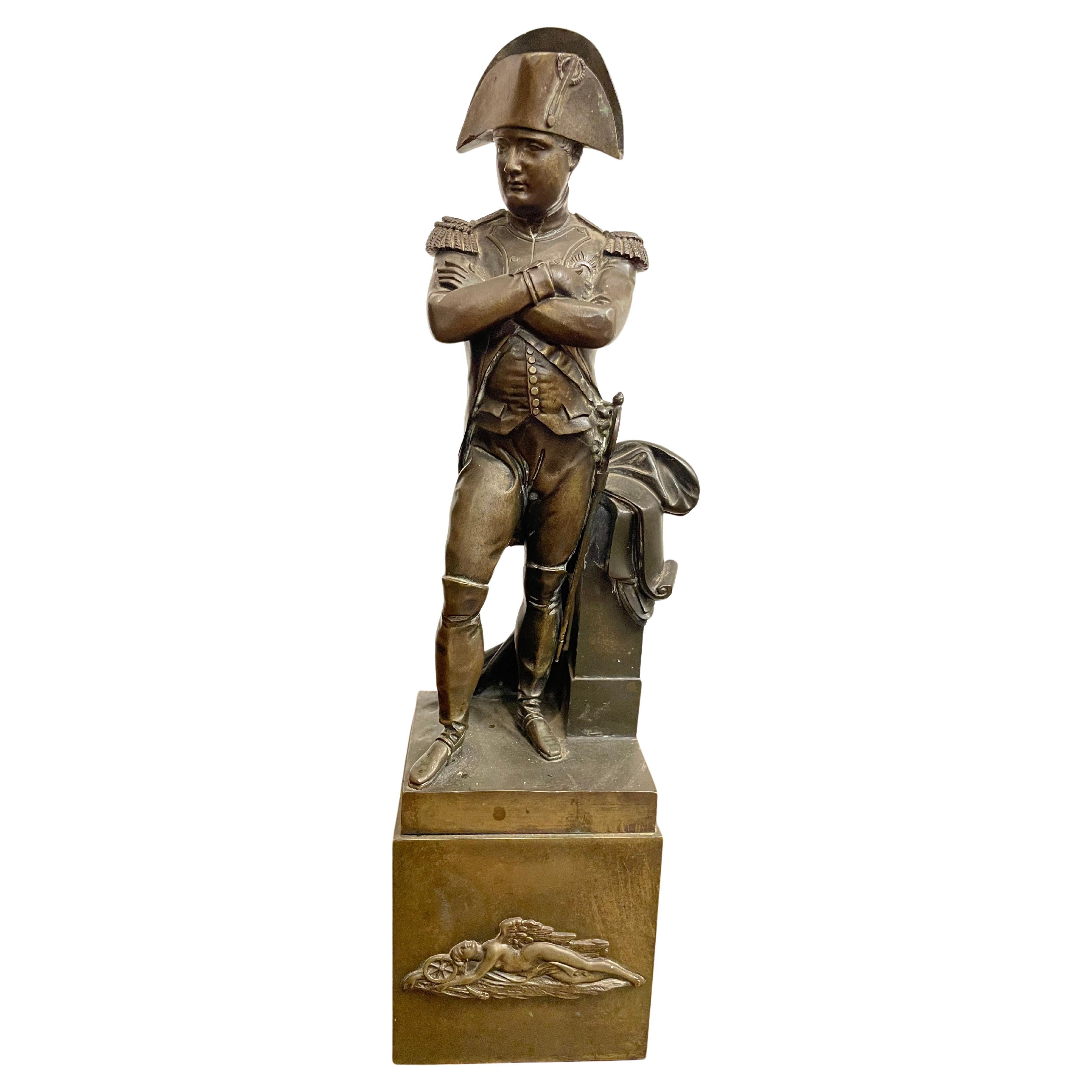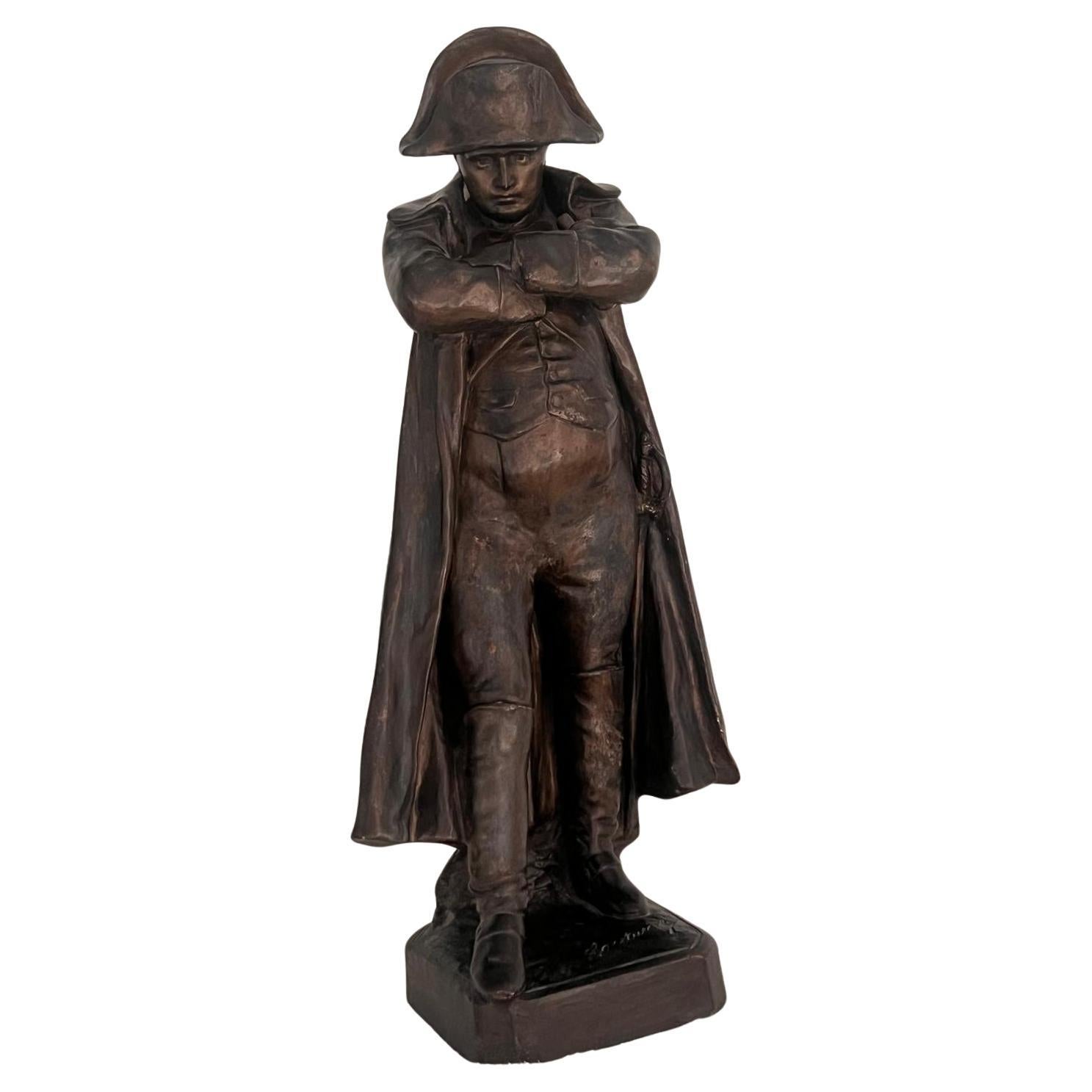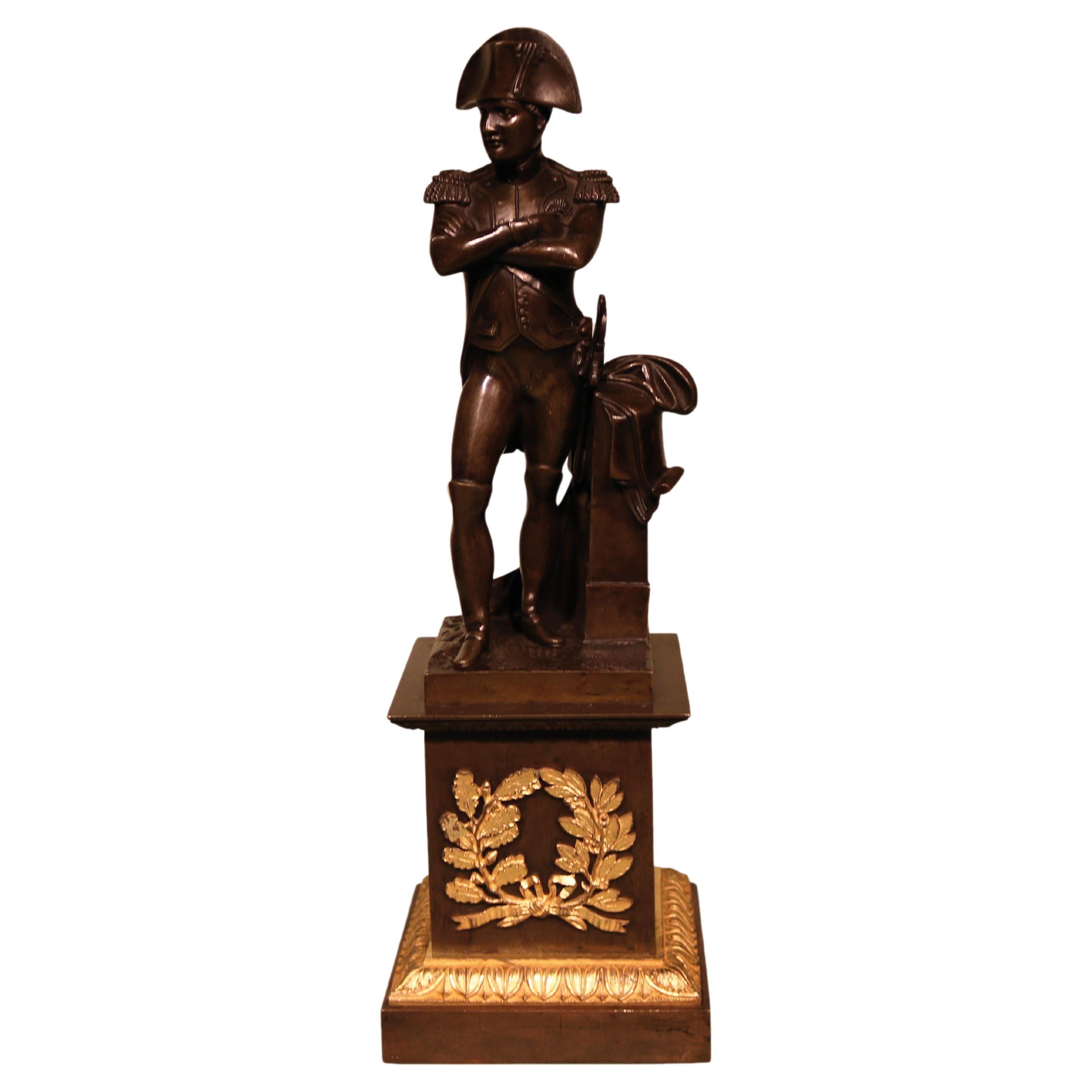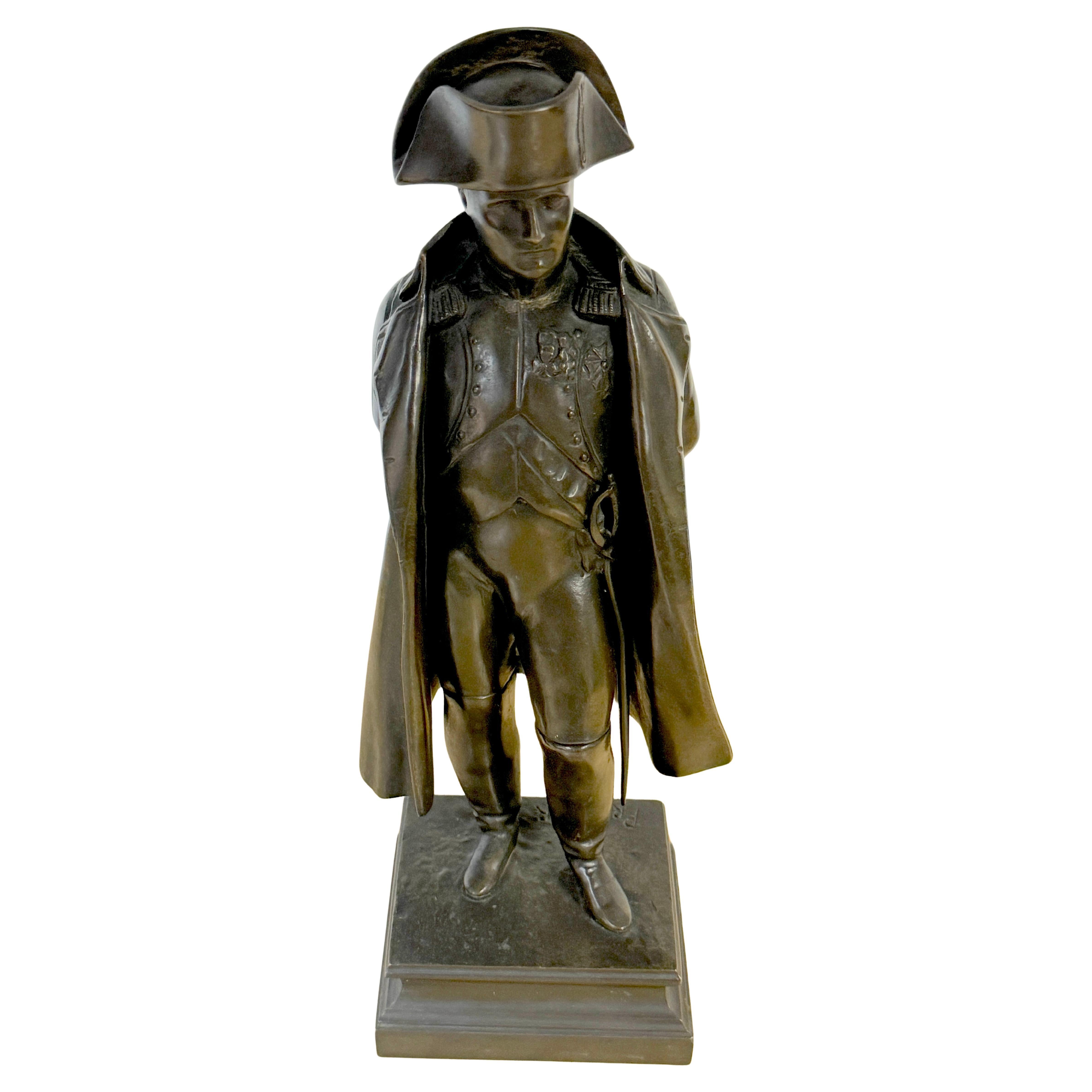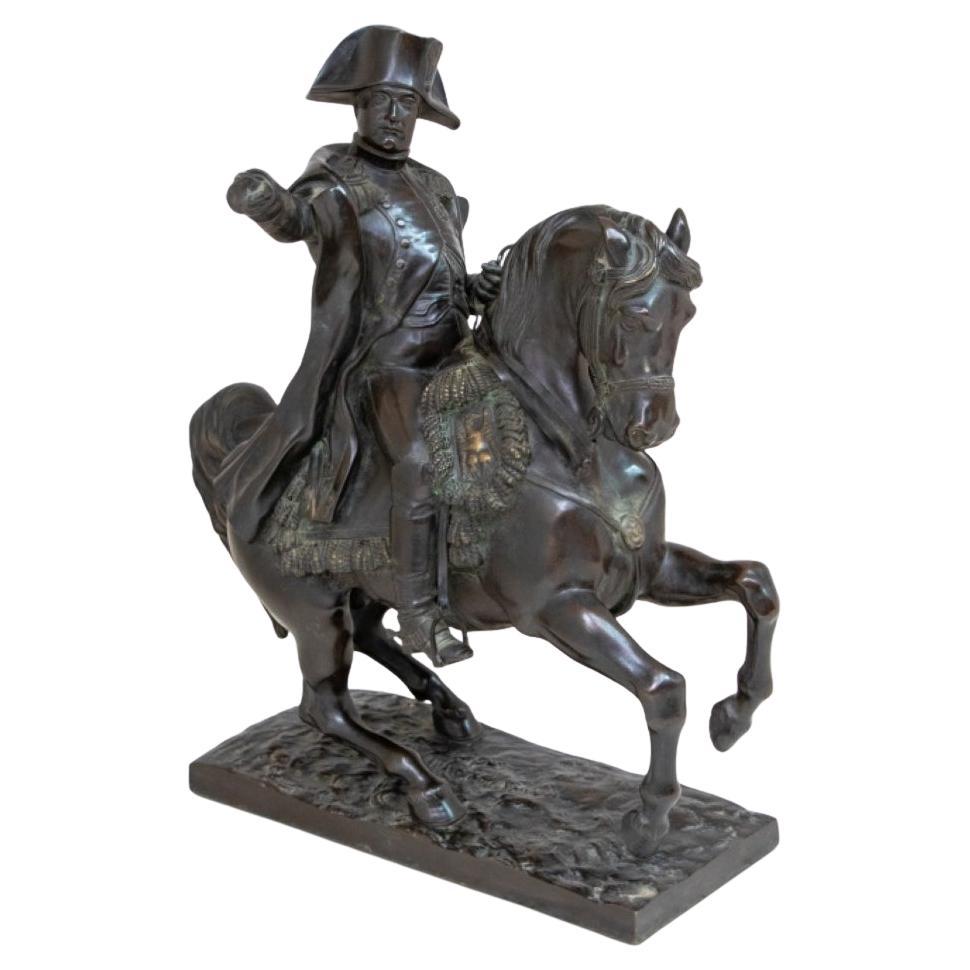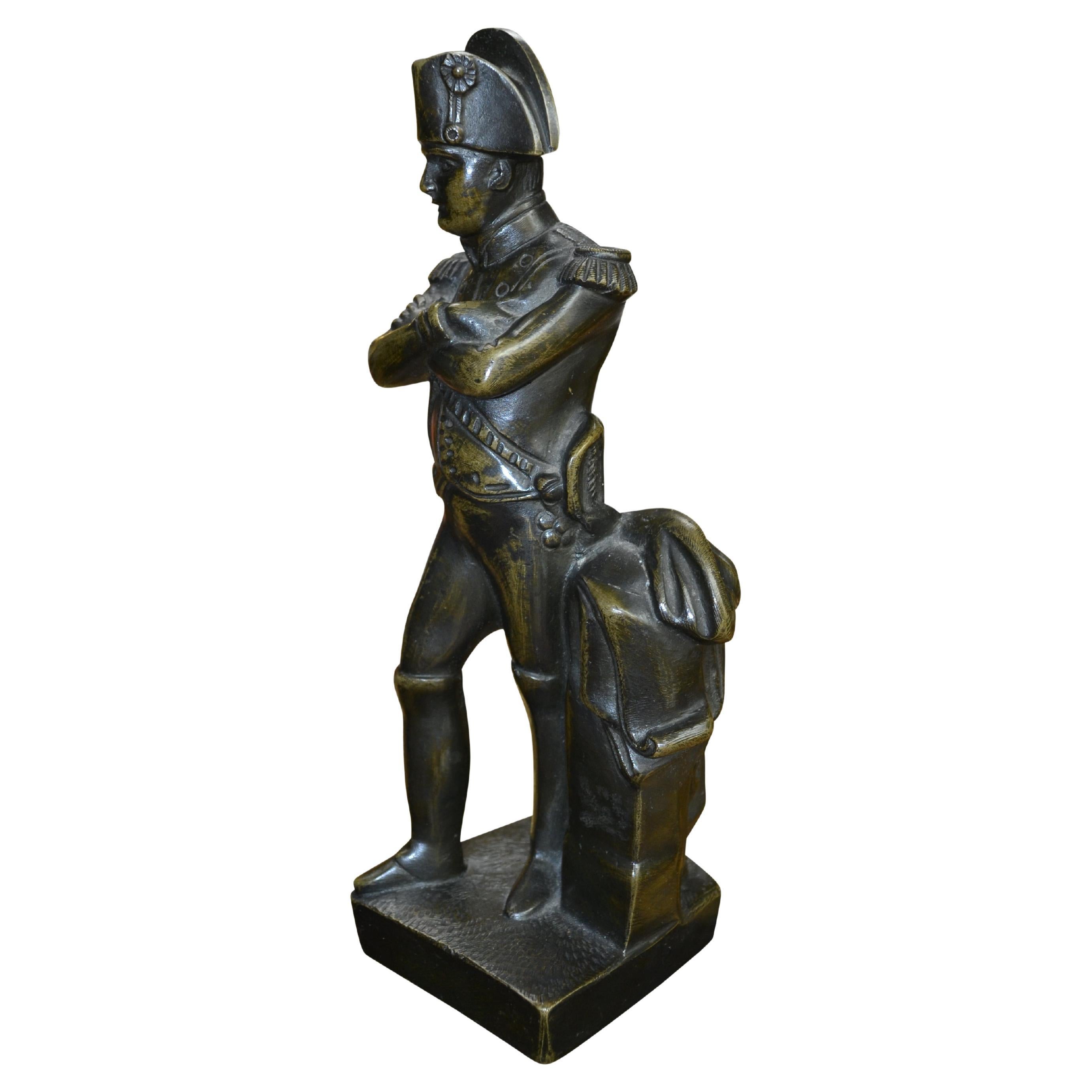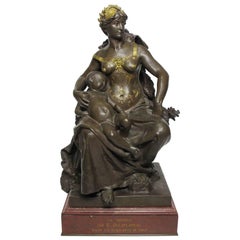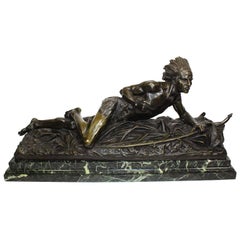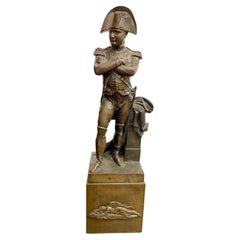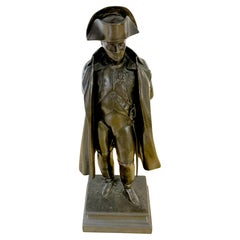Items Similar to French Bronze of Napoleon Marching in Waterloo After Marius-Jean-Antonin Mercié
Video Loading
Want more images or videos?
Request additional images or videos from the seller
1 of 19
French Bronze of Napoleon Marching in Waterloo After Marius-Jean-Antonin Mercié
$12,450
£9,260.69
€10,842.44
CA$17,371.98
A$19,439.73
CHF 10,150.51
MX$238,991.26
NOK 128,060.44
SEK 120,504.24
DKK 80,892.95
Shipping
Retrieving quote...The 1stDibs Promise:
Authenticity Guarantee,
Money-Back Guarantee,
24-Hour Cancellation
About the Item
A Fine and Large French Early 20th Century Bronze of Napoleon Marching in Waterloo Cast after a model by Marius-Jean-Antonin Mercié (French, 1845-1916). The impressive bronze sculpture in a brown patina depicting the heroic and moody figure of a marching Napoleon with a figure of a fallen eagle at his feet symbolizing his defeat in Waterloo. Circa: Paris, 1907.
Height: 33 1/4 inches (84.5 cm)
Width: 18 inches (45.7 cm)
Depth: 16 inches (40. 6 cm)
Marius Jean Antonin Mercié (October 30, 1845 in Toulouse – December 12, 1916 in Paris), was a French sculptor, medallist and painter. Mercié entered the École des Beaux-Arts, Paris, and studied under Alexandre Falguière and François Jouffroy, and in 1868 gained the Grand Prix de Rome at the age of 23. His first great popular successes were the David and Gloria Victis. The latter bronze was shown and received the Medal of Honour of the Paris Salon and was subsequently placed in the Square Montholon.
The bronze David was one of his most popular works. The Biblical hero is depicted naked with the head of Goliath at his feet like Donatello's David, but with a turbaned head and sheathing his long sword. Numerous reproductions exist, most of which incorporate a loincloth that covers David's genitalia but not his buttocks. The lifesize original is now in the Musée d'Orsay.
Mercié was appointed Professor of Drawing and Sculpture at the École des Beaux-Arts, and was elected a member of the Académie française in 1891, after being awarded the biennial prize of the Institute of 800 in 1887.[2] He was subsequently elected to grand officier of the Légion d'honneur, and in 1913 became the president of the Société des artistes français. Marie-Antoinette Demagnez was among his many students at the École des Beaux-Arts. He died in Paris on December 12, 1916
WORKS:
The Genius of the Arts (1877), a relief, is in the Tuileries, in substitution for Antoine-Louis Barye's Napoleon III. A similar work for the tomb of Jules Michelet (1879; designed with architect Jean-Louis Pascal) is in Père Lachaise Cemetery, and in the same year Mercié produced the statue of Arago with accompanying reliefs, now erected at Perpignan.
In 1882 he repeated his great patriotic success of 1874 with a group Quand Même!, replicas of which have been set up at Belfort and in the garden of the Tuileries. Le Souvenir (1885), a marble statue for the tomb of Charles Ferry, was called one of his most beautiful works by the 1911 Encyclopædia Britannica. Regret, for the tomb of Alexandre Cabanel, was produced in 1892, along with William Tell, subsequently at Lausanne.
Mercié also designed the monuments to Jean-Louis-Ernest Meissonier (1895), erected in the Jardin de l'Infante in the Louvre, and Louis Faidherbe (1896) at Lille, a statue of Adolphe Thiers set up at St Germain-en-Laye, the monument to Paul Baudry at Père Lachaise, and that of Louis-Philippe and Queen Amélie for their tomb at Dreux. His stone group of Justice is at the Hôtel de Ville, Paris.
Numerous other statues, portrait busts, and medallions came from the sculptor's hand, which gained him a medal of honor at the Paris Exhibition (1878) and the grand prix at that of 1889. Among the paintings exhibited by the artist are a Venus, to which was awarded a medal in 1883, Leda (1884), and Michelangelo studying Anatomy (1885), his most dramatic work in this medium.
Mercié is known in America primarily for three monuments: the 1890 Robert E. Lee equestrian bronze on Monument Avenue in Richmond, Virginia (the Robert E. Lee Monument), which was removed in September 2021; his 1891 collaboration with former teacher Alexandre Falguière on the statue of the Marquis de Lafayette in Lafayette Square, Washington, D.C.; and the 1911 Francis Scott Key Monument in Baltimore, Maryland.
- Creator:Marius Jean Antonin Mercié (Sculptor)
- Dimensions:Height: 33.25 in (84.46 cm)Width: 18 in (45.72 cm)Depth: 16 in (40.64 cm)
- Style:Empire (In the Style Of)
- Materials and Techniques:Bronze,Patinated
- Place of Origin:
- Period:1900-1909
- Date of Manufacture:Circa: Paris, 1907
- Condition:Wear consistent with age and use. Minor fading. A truly stunning bronze sculpture of Napoleon. Overall condition is very good with minor age wear and spotting on patina. Please view all images.
- Seller Location:Los Angeles, CA
- Reference Number:Seller: Ref.: A28451stDibs: LU1796243607202
About the Seller
5.0
Vetted Professional Seller
Every seller passes strict standards for authenticity and reliability
Established in 1982
1stDibs seller since 2016
132 sales on 1stDibs
Typical response time: 1 hour
- ShippingRetrieving quote...Shipping from: Los Angeles, CA
- Return Policy
Authenticity Guarantee
In the unlikely event there’s an issue with an item’s authenticity, contact us within 1 year for a full refund. DetailsMoney-Back Guarantee
If your item is not as described, is damaged in transit, or does not arrive, contact us within 7 days for a full refund. Details24-Hour Cancellation
You have a 24-hour grace period in which to reconsider your purchase, with no questions asked.Vetted Professional Sellers
Our world-class sellers must adhere to strict standards for service and quality, maintaining the integrity of our listings.Price-Match Guarantee
If you find that a seller listed the same item for a lower price elsewhere, we’ll match it.Trusted Global Delivery
Our best-in-class carrier network provides specialized shipping options worldwide, including custom delivery.More From This Seller
View AllFrench 19th Century Bronze Military Figure of "Blandan" after Jean Gautherin
By Jean Gautherin
Located in Los Angeles, CA
A very fine French 19th century patinated bronze figure of the French hero of the Algerian conquest, Jean-Pierre Hippolyte Blandan (1819-1842) after the French Sculptor Jean Gautheri...
Category
Antique 19th Century French Louis Philippe Figurative Sculptures
Materials
Bronze
$9,850 Sale Price
20% Off
A Monumental Bronze Sculpture of "Tartar Warrior Checking His Horse" after Barye
By Antoine-Louis Barye
Located in Los Angeles, CA
A Monumental Equestrian Patinated Bronze Group Sculpture of "Tartar Warrior Checking His Horse" after the original model by Antoine Louis Barye (French, 1795-1875). The large and hea...
Category
Late 20th Century Unknown Islamic Figurative Sculptures
Materials
Bronze
$10,325 Sale Price
30% Off
A French 19th Century Bronze Sculpture Titled "La Sécurité" Eugène Delaplanche
By Eugène Delaplanche
Located in Los Angeles, CA
A very fine French 19th century brown and parcel-gilt patinated bronze sculpture titled "La Sécurité" (The Security - Protection) after a model by Eugène Delaplanche (French, 1836–1891). Depicting a sitting young Maiden in a gilt-decorated armored suit and helmet, a lion skin on her back, holding a resting child on her arm. Raised on Rouge-Royal marble plinth inscribed "La Sécurité - Par E. Delaplanche - Salon des Beaux-Arts de Paris". Signed: E. Delaplanche and stamped with the importer's seal - Alberto Vignes y Ca - Buenos Aires, circa 1890.
Measures: Height: 28 3/4 inches (60.3 cm).
Width: 16 inches (40.7 cm).
Depth: 14 inches (35.6 cm).
Eugène Delaplanche (February 28, 1836 – January 10, 1891) was a French sculptor, born at Belleville (Seine).
He was a pupil of Duret, gained the Prix de Rome in 1864 (spending 1864-67 at the Villa Medici in Rome) and the medal of honor in 1878. His "Messenger of Love" (1874), "Aurora" (1878), and the "Virgin of the Lillies" (1884), are in the Luxembourg. Other works by him are "Music - La Musique" (1878, Paris Opera House), called his masterpiece; "Eve After the Fall" (1869); "Maternal Instruction" (1875, Square of Sainte-Clothilde, Paris). He is also noted for his decorations in relief on vases of Haviland faience. His best work is naturalistic, but at the same time dignified and simple in line and shows sound mastery of technique. He is represented by 15 works in the Glyptothek, Copenhagen and in many other French museums and in churches.
This sculpture of La Sécurité is after his 1884 sculptures...
Category
Antique Late 19th Century French Belle Époque Figurative Sculptures
Materials
Marble, Bronze
$18,450 Sale Price
47% Off
French Bronze Sculpture "Crouching Native American Indian" E. Drouot
By Edouard Drouot
Located in Los Angeles, CA
A very fine French, 19th century Patinated bronze group of a Crouching Native American Indian on the lookout, in a dark brown patina and raised on a veined green marble base, by Edou...
Category
Antique Late 19th Century French Native American Figurative Sculptures
Materials
Marble, Bronze
An Italian Cast 19th Century Bronze Group Mother & Children Titled "La Tempête"
By Mathurin Moreau
Located in Los Angeles, CA
A Fine Italian Cast 19th Century Bronze Group Titled "La Tempête" (The Tempest) Probably after Mathurin Moreau (French, 1822–1912), Cast by The Alessandro Nelli Foundry in Rome. The ...
Category
Antique Early 1900s Italian Classical Roman Figurative Sculptures
Materials
Marble, Bronze
$15,160 Sale Price
20% Off
French 19th Century Patinated Bronze Group "The Abduction of the Sabine Women"
By Pierre Loison 1
Located in Los Angeles, CA
A very fine and Monumental French 19th century patinated bronze group Titled "The Abduction of the Sabine Women" after a model by Pierre Loison (French, 1816-1886), depicting a young scantily maiden being carried away on the arms of a Roman soldier, raised on circular ebonized wood and brass revolving pedestal stand. Signed at the base: P. Loison, circa: Paris, 1870-1880.
Overall height (Sculpture and Pedestal): 91 inches (231.2 cm).
Sculpture height: 54 3/4 inches (139.1 cm).
Sculpture width: 24 inches (61 cm).
Pedestal height: 36 inches (91.5 cm).
Pedestal width (Widest): 25 1/2 inches (64.8 cm).
Pierre Loison was a French sculptor of the 19th century born in the seaside town of Loir-et-Cher on July 5, 1816 and died in Cannes on February 3, 1886. In 1841, he joined the Pierre-Jean David d'Angers workshop where he became one of his favorite pupils. A year later he attended the School of Fine Arts in Paris. He exhibited for the first time at the Salon des artistes Français where in 1845 he was awarded third-class medal. In 1853 he was awarded First Place medal and at the Universal Exhibition of 1955 he received an honorable mention and another medal award in 1859.
On 12 July 1859 and by decree, he was made "Chevalier de la Légion d’Honneur".
Pierre Loison is buried at The Montparnasse Cemetery in Paris.
Works by Pierre Loison
"Femme assise": Terre cuite (1843) au musée Gustave-Moreau à Paris
"Jeune fille portant un vase": Statue en marbre blanc, (h. 1,25 m) datée de 1857 et présentée au Salon de 1859 ; la statue fut d’abord placée au Palais-Royal (appartements du prince Napoléon) ; elle est actuellement au musée des Beaux-arts de Dole ; une réplique de taille réduite est au Musée des arts décoratifs de Paris.
"La Halle aux grains de Mer": Chaque façade de ce bâtiment, classé à l’inventaire supplémentaire des monuments historiques, comporte un fronton triangulaire et celui de la façade ouest représentant « L’Agriculture distribuant des couronnes aux enfants de Beauce et de Sologne » a été sculpté gracieusement par P. Loison, natif de la commune.
"La Justice assise": Allégorie de la Justice au fronton du Palais de justice de Blois (1847).
"Buste d’Achille Fould": Au musée du Château de Blois 8;
"Nausicaa": Statue en plâtre présentée au Salon de 1874, au musée des Beaux-arts de Vendôme.
"Statue de J-B. Pigalle sur la façade de l’hôtel de ville de Paris
"Sculptures extérieures du Palais du Louvre": Pierre Loison est l’auteur de neuf statues qui décorent les façades du Louvre "Figure" (1878) au deuxième étage du Pavillon Marsan10; "La Navigation" (1868) sur la balustrade du premier étage du Pavillon des États11; "Pandore" (1861) sur l’aile Est12; « Vénus » (1865) Aile Marsan13; "l’Histoire et la Vérité" (1857)14; "La Poésie et la Philosophie" (1857)15 deux oculi du Pavillon Mollien, coté cour Napoléon ; "Concordet" (1857) sur la balustarde du premier étage de la Rotonde de Beauvais, coté cour Napoléon.
"Statue de Sappho sur le rocher de Leucade : datée de 1859, (h. 1,85 m) sur la façade nord de la cour carrée du Palais du Louvre à Paris ; le modèle en plâtre, offert par Mme Loison, est au musée des Beaux-arts de Blois.
"Vierge à l’enfant": Statue en marbre en l’église Saint-Pierre de Dampierre-en-Yvelines.
"Jeune romain enlevant une Sabine": Groupe présenté au Salon de 1863 qui a été reproduit en bronze par la fonderie d’art Raingo frères.
"Sépulture de la famille Hautoy : Au cimetière du Père-Lachaise, deux bas-reliefs en marbre représentant l’un "La vie de Famille," l’autre 'Le chantier," datés de 1880.
"Demoiselle d’honneur de la Cour de François Ier": Statue en pierre exposée au Salon des artistes vivants en 1870 ; acquise par l’État à ce Salon, elle a été déposée en 1891, devant la mairie d’Aubin.
"La Paix distribuant des palmes aux génies des Beaux-arts": Fronton du Château de Compiègne (1866).
"Daphnis et Naïs": Groupe en marbre (1869) au musée de Picardie à Amiens.
"Jean-Baptiste Pigalle": Statue en pierre (1881) sur la façade principale, au rez-de-chaussée de l’Hôtel de ville de Paris.
"Gisant de Ferdinand-Philippe d'Orléans: dans la chapelle royale de Dreux en collaboration avec Ary Scheffer.
"La Grace": Statue en marbre (1875) dans le grand foyer de l’opéra Garnier.
The Abduction of the Sabine Women
The Abduction of the Sabine Women is an episode in the legendary history of Rome, traditionally dated to 750 BC, in which the first generation of Roman men acquired wives for themselves from the neighboring Sabine families. Recounted by Livy and Plutarch (Parallel Lives II, 15 and 19), it provided a subject for Renaissance and post-Renaissance works of art that combined a suitably inspiring example of the hardihood and courage of ancient Romans with the opportunity to depict multiple figures, including heroically semi-nude figures, in intensely passionate struggle. Comparable themes from Classical Antiquity are the Battle of the Lapiths and Centaurs and the theme of Amazonomachy, the battle of Theseus with the Amazons.
The Abduction is supposed to have occurred in the early history of Rome, shortly after its founding by Romulus and his mostly male followers. Seeking wives in order to found families, the Romans negotiated unsuccessfully with the Sabines, who populated the area. Fearing the emergence of a rival society, the Sabines refused to allow their women to marry the Romans. Consequently, the Romans planned to abduct Sabine women, during a festival of Neptune Equester and proclaimed the festival among Rome's neighbours. According to Livy, many people from Rome's neighbours including folk from the Caeninenses, Crustumini, and Antemnates, and many of the Sabines attended. At the festival Romulus gave a Signal, at which the Romans grabbed the Sabine women and fought off the Sabine men. The indignant abductees were soon implored by Romulus to accept Roman husbands.
Livy says Romulus offered them free choice and promised civic and property rights to women. According to Livy, Romulus spoke to them each in person, declaring "that what was done was owing to the pride of their fathers, who had refused to grant the privilege of marriage to their neighbours; but notwithstanding, they should be joined in lawful wedlock, participate in all their possessions and civil privileges, and, than which nothing can be dearer to the human heart, in their common children." Responsibility of the men for meeting the needs of the children thus conceived was not included.
War with the Sabines and other tribes
Outraged at the occurrence, the King of the Caeninenses entered upon Roman territory with his army. Romulus and the Romans met the Caeninenses in battle, killed their king, and routed their army. Romulus later attacked Caenina and took it upon the first assault. Returning to Rome, he dedicated a temple to Jupiter Feretrius (according to Livy, the first temple dedicated in Rome) and offered the spoils of the enemy king as spolia opima. According to the Fasti Triumphales, Romulus celebrated a triumph over the Caeninenses on 1 March 752 BC.
At the same time, the army of the Antemnates invaded Roman territory. The Romans retaliated, and the Antemnates were defeated in battle and their town captured. According to the Fasti Triumphales, Romulus celebrated a second triumph in 752 BC over the Antemnates.
The Crustumini also started a war, but they too were defeated and their town captured.
Roman colonists subsequently were sent to Antemnae and Crustumerium by Romulus, and many citizens of those towns also migrated to Rome (particularly the families of the captured women).
The Sabines themselves finally declared war, led into battle by their king, Titus Tatius. Tatius almost succeeded in capturing Rome, thanks to the treason of Tarpeia, daughter of Spurius Tarpeius, governor of the citadel on the Capitoline Hill. She opened the city gates for the Sabines in return for "what they bore on their arms", thinking she would receive their golden bracelets. Instead, the Sabines crushed her to death with their shields, and her body was thrown from a rock known ever since by her name, the Tarpeian Rock.
The Romans attacked the Sabines, who now held the citadel. The Roman advance was led by Hostus Hostilius, the Sabine defence by Mettus Curtius. Hostus fell in battle, and the Roman line gave way, They retreated to the gate of the Palatium. Romulus rallied his men by promising to build a temple to Jupiter Stator on the site. He then led them back into battle. Mettus Curtius was unhorsed and fled on foot, and the Romans appeared to be winning.
At this point, however, the Sabine women intervened:
[They], from the outrage on whom the war originated, with hair dishevelled and garments rent, the timidity of their sex being overcome by such dreadful scenes, had the courage to throw themselves amid the flying weapons, and making a rush across, to part the incensed armies, and assuage their fury; imploring their fathers on the one side, their husbands on the other, "that as fathers-in-law and sons-in-law they would not contaminate each other with impious blood, nor stain their offspring with parricide, the one their grandchildren, the other their children. If you are dissatisfied with the affinity between you, if with our marriages, turn your resentment against us; we are the cause of war, we of wounds and of bloodshed to our husbands and parents. It were better that we perish than live widowed or fatherless without one or other of you."
The battle came to an end, and the Sabines agreed to unite in one nation with the Romans. Titus Tatius jointly ruled with Romulus until Tatius's death five years later.
The new Sabine residents of Rome settled on the Capitoline Hill, which they had captured in the battle.
Artistic representations:
The Rape of the Sabine Women by Johann Heinrich Schönfeld
The subject was popular during the Renaissance as symbolising the importance of marriage for the continuity of families and cultures. It was also an example of a battle subject in which the artist could demonstrate his skill in depicting female as well as male figures in extreme poses, with the added advantage of a sexual theme. It was depicted regularly on 15th-century Italian cassoni and later in larger paintings. A comparable opportunity from the New Testament was afforded by the theme of the Massacre of the Innocents.
Giambologna
The sculpture by Giambologna (1579–1583) that was reinterpreted as expressing this theme depicts three figures (a man lifting a woman into the air while a second man crouches) and was carved from a single block of marble. This sculpture is considered Giambologna's masterpiece. Originally intended as nothing more than a demonstration of the artist's ability to create a complex sculptural group, its subject matter, the legendary rape of the Sabines, had to be invented after Francesco I de' Medici, Grand Duke of Tuscany, decreed that it be put on public display in the Loggia dei Lanzi in Piazza della Signoria, Florence. True to mannerist densely packed, intertwined figural compositions and ambitious overinclusive efforts, the statue renders a dynamic panoply of emotions, in poses that offer multiple viewpoints. When contrasted with the serene single-viewpoint pose of the nearby Michelangelo's David, finished nearly 80 years before, this statue is infused with the dynamics that lead towards Baroque, but the tight, uncomfortable, verticality— self-imposed by the author's virtuosic restriction to a composition that could be carved from a single block of marble— lacks the diagonal thrusts that Bernini would achieve forty years later with his Rape of Proserpina and Apollo and Daphne, both at the Galleria Borghese, Rome.
The proposed site for the sculpture, opposite Benvenuto Cellini's statue of Perseus, prompted suggestions that the group should illustrate a theme related to the former work, such as the rape of Andromeda by Phineus. The respective rapes of Proserpina and Helen were also mooted as possible themes. It was eventually decided that the sculpture was to be identified as one of the Sabine virgins.
The work is signed OPVS IOANNIS BOLONII FLANDRI MDLXXXII ("The work of Johannes of Boulogne of Flanders, 1582"). An early preparatory bronze featuring only two figures is in the Museo Nazionale di Capodimonte in Naples. Giambologna then revised the scheme, this time with a third figure, in two wax models now in the Victoria and Albert Museum, London. The artist's full-scale gesso for the finished sculpture, executed in 1582, is on display at the Accademia Gallery in Florence.
Bronze reductions of the sculpture, produced in Giambologna's own studio and imitated by others, were a staple of connoisseurs' collections into the 19th century.
Nicolas Poussin
Nicolas Poussin produced two major versions of this subject, which enabled him to display to the full his unsurpassed antiquarian knowledge, together with his mastery of complicated relations of figures in dramatic encounter. One, now at the Metropolitan Museum of Art, was executed in Rome, 1634–35. It depicts Romulus at the left giving the Signal for the abduction.
The second version, of 1636–37, now at the Louvre Museum, shows that, though some of the principal figures are similar, he had not exhausted the subject. The architectural setting is more developed.
Peter Paul Rubens
Peter Paul Rubens painted a version of the subject about 1635–40. It is at the National Gallery, London.
Jacques-Louis David
Jacques-Louis David painted the other end of the story, when the women intervene to reconcile the warring parties. The Sabine Women Enforcing Peace by Running Between the Combatants (also known as The Intervention of the Sabine Women ) was completed in 1799. It is in the Louvre Museum.
David had worked on it from 1796, when France was at war with other European nations after a period of civil conflict culminating in the Reign of Terror and the Thermidorian Reaction, during which David himself had been imprisoned as a supporter of Robespierre. After David’s estranged wife visited him in jail, he conceived the IDEA of telling the story, to honor his wife, with the theme being love prevailing over conflict. The painting was also seen as a plea for the people to reunite after the bloodshed of the revolution.
The painting depicts Romulus's wife Hersilia — the daughter of Titus Tatius, leader of the Sabines — rushing between her husband and her father and placing her babies between them. A vigorous Romulus prepares to strike a half-retreating Tatius with his spear, but hesitates. Other soldiers are already sheathing their swords.
The rocky outcrop in the background is the Tarpeian Rock.
John Leech
The English 19th century satirical painter John Leech included in his Comic History of Rome a depiction of the Rape of the Sabine Women, where the women are portrayed, with a deliberate anachronism, in Victorian costume...
Category
Antique 19th Century French Mannerist Figurative Sculptures
Materials
Bronze
$55,880 Sale Price / set
55% Off
You May Also Like
A Bronze Figure of Napoleon, 19th Century
Located in ARMADALE, VIC
A Bronze Figure of Napoleon, 19th Century
Provenance:
Private Melbourne Collection.
Description:
In full military dress, his sword sheathed and arms folded over his chest, his ri...
Category
Antique 19th Century French Empire Figurative Sculptures
Materials
Bronze
Bronze Napoleon Sculpture, Signed Couturier, French Mid Century
By Robert Couturier
Located in London, GB
A very contented Napoleon sculpture in dark bronze patina. Signed Couturier
On the terracotta base. France late mid century
Category
Vintage 1940s French Régence Figurative Sculptures
Materials
Bronze
19th Century French Bronze Figure of Napoleon
Located in London, GB
An early 19th Century well-cast bronze statue of Napoleon in full uniform, standing on square socle with applied ormolu laurel leaf wreath, ending o...
Category
Antique Early 19th Century French Empire Figurative Sculptures
Materials
Bronze, Ormolu
Jean Jacques Pradier (1790-1852) Bronze Napoleon Bonaparte
By J. Pradier
Located in West Palm Beach, FL
Jean Jacques Pradier (1790-1852) Bronze Napoleon Bonaparte
James Pradier (born Jean-Jacques Pradier, 1790–1852) was a Genevan-born French sculptor best known for his work in the neoclassical style, one of the primary artists of Napoleon's tomb, Les Invalides.
This exceptional 19th-century French bronze full-length portrait of a standing Napoleon Bonaparte bronze...
Category
Antique 19th Century French Empire Revival Figurative Sculptures
Materials
Bronze
Comte de Nieuwerkerke "Napoleon I" Bronze
By Count Alfred Émilien O'Hara van Nieuwerkerke
Located in Astoria, NY
Comte de Nieuwerkerke (Alfred Emilein O'Hara, French, 1811-1892) "Napoleon I" Patinated Equestrian Bronze, cast by Susse Freres, Paris, late 19th century, the emperor on horseback wi...
Category
Antique 19th Century French Neoclassical Figurative Sculptures
Materials
Bronze
A Patinated Bronze Sculpture of Napoleon after Guillemin
By Émile Guillemin
Located in Vancouver, British Columbia
A small solidly cast nicely patinated bronze statue of a uniformed standing Napoleon arms crossed and wearing his iconic bicorne hat after a model by late 19 Century French sculpto...
Category
Early 20th Century French Neoclassical Revival Figurative Sculptures
Materials
Bronze
$680 Sale Price
20% Off
More Ways To Browse
French Marquis
Baltimore Antique Furniture
Napoleon Medallions
Marble Relief Portrait
Early American Reproduction
Portrait Of Napoleon Iii
Used Furniture Waterloo
Antique Furniture Richmond
Richmond Virginia
Marie Antoinette Portrait
Erector Set
Robert Sword
Marquis De Lafayette
Woven Rush Chair
1960s Rocking Chair
1970s Orange Chair
Antique Arts And Crafts Side Table
Antique Painted Coffee Table
